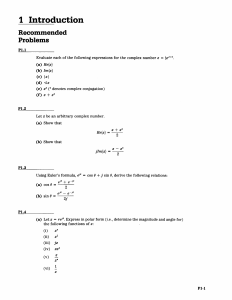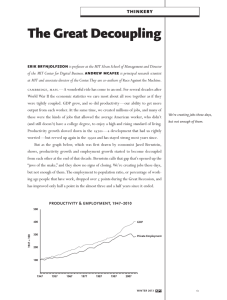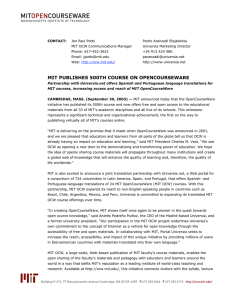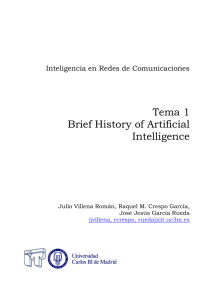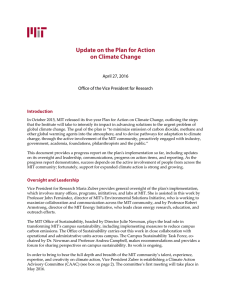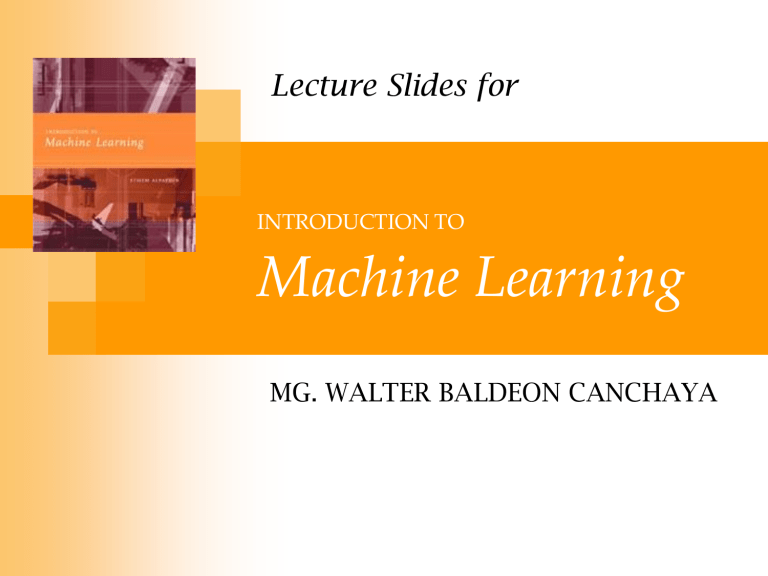
Lecture Slides for INTRODUCTION TO Machine Learning MG. WALTER BALDEON CANCHAYA CHAPTER 1: Introduction Why “Learn” ? Machine learning is programming computers to optimize a performance criterion using example data or past experience. There is no need to “learn” to calculate payroll Learning is used when: Human expertise does not exist (navigating on Mars), Humans are unable to explain their expertise (speech recognition) Solution changes in time (routing on a computer network) Solution needs to be adapted to particular cases (user biometrics) 3 Lecture Notes for E Alpaydın 2004 Introduction to Machine Learning © The MIT Press (V1.1) What We Talk About When We Talk About“Learning” Learning general models from a data of particular examples Data is cheap and abundant (data warehouses, data marts); knowledge is expensive and scarce. Example in retail: Customer transactions to consumer behavior: People who bought “Da Vinci Code” also bought “The Five People You Meet in Heaven” (www.amazon.com) Build a model that is a good and useful approximation to the data. 4 Lecture Notes for E Alpaydın 2004 Introduction to Machine Learning © The MIT Press (V1.1) Data Mining Retail: Market basket analysis, Customer relationship management (CRM) Finance: Credit scoring, fraud detection Manufacturing: Optimization, troubleshooting Medicine: Medical diagnosis Telecommunications: Quality of service optimization Bioinformatics: Motifs, alignment Web mining: Search engines ... 5 Lecture Notes for E Alpaydın 2004 Introduction to Machine Learning © The MIT Press (V1.1) What is Machine Learning? Optimize a performance criterion using example data or past experience. Role of Statistics: Inference from a sample Role of Computer science: Efficient algorithms to Solve the optimization problem Representing and evaluating the model for inference 6 Lecture Notes for E Alpaydın 2004 Introduction to Machine Learning © The MIT Press (V1.1) Applications Association Supervised Learning Classification Regression Unsupervised Learning Reinforcement Learning 7 Lecture Notes for E Alpaydın 2004 Introduction to Machine Learning © The MIT Press (V1.1) Learning Associations Basket analysis: P (Y | X ) probability that somebody who buys X also buys Y where X and Y are products/services. Example: P ( chips | beer ) = 0.7 8 Lecture Notes for E Alpaydın 2004 Introduction to Machine Learning © The MIT Press (V1.1) Classification Example: Credit scoring Differentiating between low-risk and high-risk customers from their income and savings Discriminant: IF income > θ1 AND savings > θ2 THEN low-risk ELSE high-risk 9 Lecture Notes for E Alpaydın 2004 Introduction to Machine Learning © The MIT Press (V1.1) Classification: Applications Aka Pattern recognition Face recognition: Pose, lighting, occlusion (glasses, beard), make-up, hair style Character recognition: Different handwriting styles. Speech recognition: Temporal dependency. Use of a dictionary or the syntax of the language. Sensor fusion: Combine multiple modalities; eg, visual (lip image) and acoustic for speech Medical diagnosis: From symptoms to illnesses ... 10 Lecture Notes for E Alpaydın 2004 Introduction to Machine Learning © The MIT Press (V1.1) Face Recognition Training examples of a person Test images AT&T Laboratories, Cambridge UK http://www.uk.research.att.com/facedatabase.html 11 Lecture Notes for E Alpaydın 2004 Introduction to Machine Learning © The MIT Press (V1.1) Regression Example: Price of a used car x : car attributes y : price y = g (x | θ ) g ( ) model, θ parameters y = wx+w0 12 Lecture Notes for E Alpaydın 2004 Introduction to Machine Learning © The MIT Press (V1.1) Regression Applications Navigating a car: Angle of the steering wheel (CMU NavLab) Kinematics of a robot arm (x,y) α2 α1= g1(x,y) α2= g2(x,y) α1 Response surface design 13 Lecture Notes for E Alpaydın 2004 Introduction to Machine Learning © The MIT Press (V1.1) Supervised Learning: Uses Prediction of future cases: Use the rule to predict the output for future inputs Knowledge extraction: The rule is easy to understand Compression: The rule is simpler than the data it explains Outlier detection: Exceptions that are not covered by the rule, e.g., fraud 14 Lecture Notes for E Alpaydın 2004 Introduction to Machine Learning © The MIT Press (V1.1) Unsupervised Learning Learning “what normally happens” No output Clustering: Grouping similar instances Example applications Customer segmentation in CRM Image compression: Color quantization Bioinformatics: Learning motifs 15 Lecture Notes for E Alpaydın 2004 Introduction to Machine Learning © The MIT Press (V1.1) Reinforcement Learning Learning a policy: A sequence of outputs No supervised output but delayed reward Credit assignment problem Game playing Robot in a maze Multiple agents, partial observability, ... 16 Lecture Notes for E Alpaydın 2004 Introduction to Machine Learning © The MIT Press (V1.1) Resources: Datasets UCI Repository: http://www.ics.uci.edu/~mlearn/MLRepository.html UCI KDD Archive: http://kdd.ics.uci.edu/summary.data.application.html Statlib: http://lib.stat.cmu.edu/ Delve: http://www.cs.utoronto.ca/~delve/ 17 Lecture Notes for E Alpaydın 2004 Introduction to Machine Learning © The MIT Press (V1.1) Resources: Journals Journal of Machine Learning Research www.jmlr.org Machine Learning Neural Computation Neural Networks IEEE Transactions on Neural Networks IEEE Transactions on Pattern Analysis and Machine Intelligence Annals of Statistics Journal of the American Statistical Association ... 18 Lecture Notes for E Alpaydın 2004 Introduction to Machine Learning © The MIT Press (V1.1) Resources: Conferences International Conference on Machine Learning (ICML) ICML05: http://icml.ais.fraunhofer.de/ European Conference on Machine Learning (ECML) ECML05: http://ecmlpkdd05.liacc.up.pt/ Neural Information Processing Systems (NIPS) NIPS05: http://nips.cc/ Uncertainty in Artificial Intelligence (UAI) UAI05: http://www.cs.toronto.edu/uai2005/ Computational Learning Theory (COLT) COLT05: http://learningtheory.org/colt2005/ International Joint Conference on Artificial Intelligence (IJCAI) IJCAI05: http://ijcai05.csd.abdn.ac.uk/ International Conference on Neural Networks (Europe) ICANN05: http://www.ibspan.waw.pl/ICANN-2005/ ... 19 Lecture Notes for E Alpaydın 2004 Introduction to Machine Learning © The MIT Press (V1.1)
